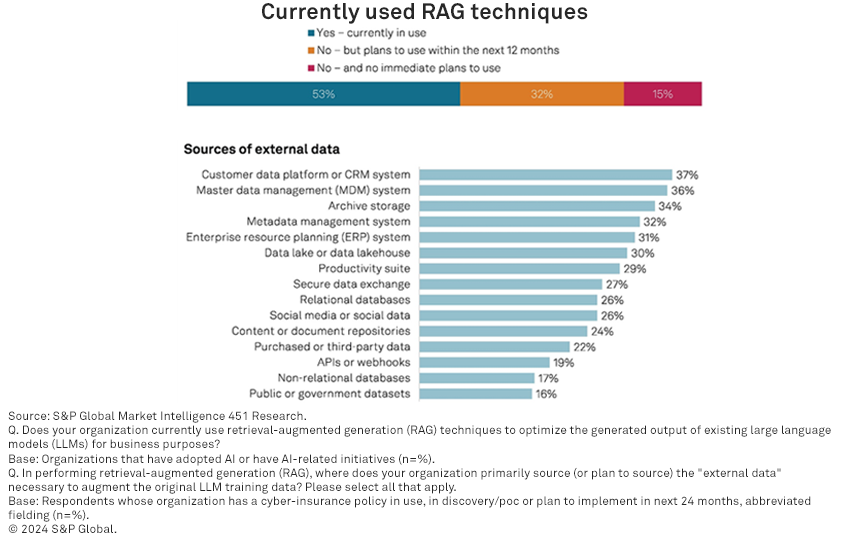
Source: © Marco Bottigelli/Moment via Getty Images.
Application programming interfaces (APIs) are essential for linking data, applications, infrastructure, and devices, making them a backbone of modern IT architecture. In the past two decades, the API economy has experienced significant growth in the types and use of APIs. Before GenAI’s introduction to the market in late 2022, we estimate that the number of APIs used within organizations was increasing by 20-30% annually. GenAI will likely drive the next wave of API growth, prompting a need for new API management (APIM) ecosystems, platforms and technical capabilities.
What are some of the factors driving API growth?
Chatbots and co-pilots are advancing into GenAI-powered digital assistants, integrated across various applications within organizations. This is just one example that’s driving increased API usage for real-time data access along with acceleration of large language models (LLMs, foundational models needed for GenAI). GenAI and LLMs promote demand for retrieval-augmented generation (RAG), a subset of GenAI that combines AI models with external data retrieval systems to enhance generative capabilities, heavily relying on APIs. According to 451 Research, a part of S&P Global Market Intelligence, 53% of organizations are already using RAG for diverse data types, with 32% planning adoption within the next year, indicating substantial API growth potential.

GenAI and LLMs demand substantial data for training and operation, increasing the need for APIs that deliver real-time data, specialized content, or insights to support AI-driven processes. As organizations implement diverse AI-powered solutions, they frequently need new data types and services.
Integrating GenAI across platforms will create a more interconnected IT landscape, increasing API calls as business functions interact more. GenAI’s integration with technologies like IoT and blockchain could enable new business models, while encouraging microservices adoption enhances scalability and agility.
These factors suggest a significant growth wave driven by GenAI’s influence.
Projecting the growth of APIs
Estimating the growth rate of API calls in GenAI applications is complex, with no straightforward rule. However, insights from business and IT leaders, along with research, provide some guidance on potential API growth for GenAI tools. On average, GenAI applications can increase API usage by 25% to 50%, depending on complexity. Basic applications like chatbots might use 3 to 10 APIs, while intermediate ones, such as customer service platforms, may require 10 to 30. Complex applications, like predictive analytics, could use 25 to 50 APIs. Advanced applications, such as those in supply chain or financial trading, might need 30 to over 100 APIs. Some organizations anticipate deploying hundreds or thousands of AI-enabled applications, quickly multiplying API needs.
How to prepare for a potential future state in APIM
Most organizations already utilize various APIM tools to track key performance indicators (KPIs) like uptime, latency, and API usage. As GenAI applications expand, IT teams must enhance their APIM capabilities to manage the growing complexity and volume of API interactions.
GenAI can help by automating tasks such as code generation, documentation, testing, security management, and performance optimization. However, the autonomous nature of AI applications could lead to unpredictable API interactions, necessitating improved orchestration and governance.
GraphQL is gaining popularity for managing APIs by unifying multiple data sources behind a single endpoint. While it simplifies data requests, maintaining and scaling GraphQL APIs can be challenging. Apollo Federation’s Graph architecture addresses this by using interconnected subgraphs, offering a unified view of data sources and better orchestration for complex use cases. As GenAI grows, organizations should consider integrating these approaches into their API ecosystems.
Vendor watch list
Here is a brief overview of some vendors and their offerings that support or enhance APIs within GenAI-enabled applications:
Workato – Workato is an integration and automation platform that focuses on enabling users to automate business workflows by connecting various applications and services. While Workato is best known for these capabilities, it also offers a suite of API management tools to manage APIs effectively within the context of their broader automation and integration needs.
Amazon Web Services – Amazon API Gateway: A fully managed service that allows developers to create, publish, maintain, monitor and secure APIs at scale. It supports RESTful APIs and WebSocket APIs, and integrates tightly with other AWS services like Lambda for serverless architectures. Also provides features like traffic management, authorization and access control, along with monitoring and throttling capabilities.
Apollo – Apollo GraphOS is a comprehensive platform for managing, deploying and scaling GraphQL APIs. It is designed to support the entire lifecycle of a GraphQL API, from development and testing to deployment and monitoring. Apollo GraphOS is particularly focused on providing the tools necessary to manage complex GraphQL architectures including federated schemas, performance monitoring and security.
Axway – API Management is part of the Axway Amplify platform, which provides a suite of tools for API lifecycle management, integration and governance. It includes an API gateway, developer portal and tools for security and analytics. It is used in environments that require hybrid and multicloud deployments, as well as those that need to comply with stringent regulatory requirements.
Boomi – API Management: Boomi made two strategic acquisitions to add to its existing APIM capabilities. It acquired APIIDA’s federated APIM business, which will add an API control plane to Boomi enabling federated API Management capabilities and a centralized platform for provisioning, discovering and securing APIs. Boomi also acquired the Mashery APIM assets from Cloud Software Group and will use the Mashery technology to help its customers build and scale their API programs across its global cloud offering.
Google – Apigee provides a comprehensive API management platform that includes tools for designing, securing, deploying, monitoring and scaling APIs. It can manage APIs across hybrid and multicloud environments. It includes advanced analytics, API versioning, monetization feature, and a developer portal. It is widely used by enterprises for its security features and ability to handle high traffic volumes.
Gravitee – Gravitee.io is an API lifecycle management platform that can manage, secure and govern nearly all types of APIs regardless of in-place API gateways or event brokers. It specializes in event-driven APIs and can expose event and message broker resources as REST, WebSocket, WebHooks and Server-sent events APIs.
IBM Corp. – API Connect is a comprehensive APIM offering that provides tools for API lifecycle management from creation and management to security and analytics. It includes a developer portal and API gateway and supports microservices. It integrates with IBM’s broader suite of enterprise technologies, making it suitable for large organizations with complex IT environments.
Kong – Kong is an API gateway and microservices management layer that helps manage, secure, and extend APIs. It offers both an open-source version and an enterprise edition with advanced features like analytics, API lifecycle management and a strong plug-in architecture. Kong Gateway version 3.6 offers six plug-ins that are focused on AI and integrate with LLMs and able to orchestrate AI flows in clouds or on self-hosted LLMs.
Microsoft Corp. – Azure API Management is a cloud-based, fully managed service from Microsoft Azure to create, manage and secure APIs. It offers a scalable API gateway, analytics, a developer portal and security features like OAuth 2.0 and OpenID Connect. It is well integrated with other Azure services, making it valuable for enterprises using the Microsoft ecosystem.
NevaTech – Sentinet is a lightweight, scalable APIM and API governance platform built entirely on the Microsoft platform and covers on-premises, cloud and hybrid environments in a unified offering. It features include an API Repository (catalog), API Gateway, API Manager and a developer portal.
Oracle Corp. – Oracle API Platform is part of Oracle’s broader integration and cloud service offerings. It provides tools for API design, deployment and management, with a strong focus on security and governance. The platform is well integrated with Oracle’s cloud infrastructure and enterprise applications, making it a strong choice for organizations already using Oracle technologies. Apiary was acquired by Oracle in 2017. It has since been integrated into Oracle’s broader API management and cloud offerings, but it remains a stand-alone tool for API design and documentation.
Postman – Postman is an API lifecycle management platform for building and using APIs. It includes design collaboration capabilities, a repository and set of tools for design, testing/mocking and documentation. It provides means to share and discover APIs.
Red Hat (part of IBM) – 3scale is an APIM platform that provides API lifecycle management, including design, security and analytics. It offers a flexible deployment model with both cloud and on-premises options. It is integrated with Red Hat’s broader product suite, making it suitable for enterprises leveraging open-source technologies.
Salesforce Inc. – MuleSoft Anypoint Platform is a unified integration platform that enables organizations to design, deploy and manage APIs and integrations across cloud and on-premises environments. It includes an API gateway, developer portal and analytics. It can integrate with various enterprise systems, making it a popular choice for complex enterprise environments.
SAP SE – SAP API Management is part of SAP’s Integration Suite, offering tools to design, publish and manage APIs. It includes a developer portal and features for security and analytics. SAP API Management is tailored for organizations using SAP ecosystems, providing integration with SAP’s ERP, CRM and other enterprise applications.
Tyk – Tyk is an open-source API gateway and management platform that provides a lightweight offering for managing APIs. It includes features such as API rate limiting, authentication, analytics and a developer portal. It supports various deployment options, including cloud, on-premises and hybrid environments.
WSO2 – API Manager is an open-source APIM offering that includes tools for creating, publishing and managing APIs. It supports API security, rate limiting, analytics and versioning. It is customizable and integrates with WSO2’s broader middleware offerings designed for complex integration challenges.
Want insights on consumer technology trends delivered to your inbox? Join the 451 Alliance.
This content may be AI-assisted and is composed, reviewed, edited and approved by S&P Global in accordance with our Terms of Service.
Do you have your finger on the pulse of tech trends? Join the 451 Alliance for exclusive research content on industry-wide IT advancements. Do I qualify?
This content may be AI-assisted and is composed, reviewed, edited and approved by S&P Global in accordance with our Terms of Service.

